Book-lovers in the region are likely aware that Samuel Clemens – a.k.a. Mark Twain – penned such classics asAdventures of Huckleberry Finn and The Adventures of Tom Sawyer on the top floor of a Victorian home which still stands at the corner of Farmington Avenue and Forest Street in Hartford. And that just a stone’s throw away, the former home of Harriet Beecher Stowe offers visitors a glimpse into the life of the renowned author ofUncle Tom’s Cabin.
But they may not know that they can retrace the footsteps of American modernist poet Wallace Stevens, following the route he traveled daily between his home in Hartford’s West End and his executive job at The Hartford as he composed his verse. Or that the childhood home of author Madeleine L’Engle – as well as the real-life inspiration for the setting in her novel A Wrinkle in Time – can be found in the Litchfield Hills.
Before the colder weather strikes, Connecticut residents who tend to spend their winter leisure hours curled up inside with a book can indulge their bibliophilic tendencies by traveling along a book trail of sorts. Enjoy the fall foliage, while visiting the literary landmarks scattered across Litchfield and Hartford counties and peppering the shoreline. Ranging from famous authors’ homes to the settings of classic books, these literary destinations suggest that our state served as a muse for some of the country’s most beloved writers. Here, the top picks in our area:
Where Connecticut Writers Wrote
The homes of several of this country’s literary greats, preserved as historical landmarks and open to the public, offer guests an opportunity to peek into the lives of the creators of some of their favorite tomes:
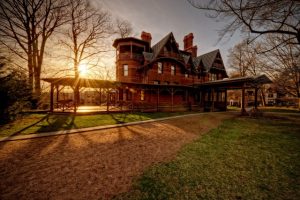 The Mark Twain House & Museum
The Mark Twain House & Museum
After Mark Twain visited Hartford (then a publishing hub) in 1871 to meet with the publisher of his first book, The Innocents Abroad, he commented in a letter to a San Francisco newspaper, “I think this is the best built and handsomest town I have ever seen.” A few years later, he built his dream house in the Nook Farm neighborhood bordering the Park River in Hartford – right next door to another literary powerhouse, Harriet Beecher Stowe. (Another notable neighbor, writer Charles Dudley Warner, would later collaborate with Twain to produce The Gilded Age.) Today, visitors can tour the restored 25-room Victorian Gothic home, including the billiard room/study where Twain sequestered himself at a desk in the corner to create the works that went on to become American literary classics. Ranked as one of the top 10 best historic homes in the world by National Geographic, the Mark Twain House & Museum gives Twain fans an intimate look into the scribe’s domestic life, and also offers an array of cultural programs, including book talks and writing workshops. The library, where Clemens once made up stories for his daughters, incorporating objects now replicated on the mantel and featuring the young girls portrayed in an oil painting that still hangs on the library wall, is periodically opened to aspiring authors for three uninterrupted hours of writing in this historic setting, imbued with the spirit of this literary genius.
Mark Twain House & Museum, 351 Farmington Avenue, Hartford. (marktwainhouse.org)
The Harriet Beecher Stowe House
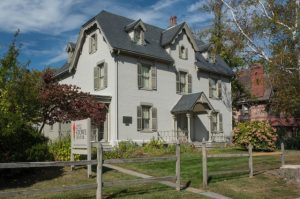
The 5,000-square-foot cottage-style home next door to the Mark Twain House celebrates the life and legacy of the author whose most famous work, Uncle Tom’s Cabin,exposed the inhumanity of slavery and strengthened the abolitionist movement in this country. Though the 1871 house is furnished with ornate Victorian-style furniture characteristic of the period, the homey interior gives visitors an impression of the writer’s artsy and down-to-earth sensibility. Several of her own paintings hang on the walls, and a sitting room off the bedroom contains a bureau, nightstand, and cane chair decorated by Stowe, herself. The house is surrounded by historic gardens featuring some of the author’s favorite flowers, as well as plants that were popular in Victorian-era gardens. The “Wildflower Garden” on the side of the house, for example, reflects the author’s love of wildflowers – she planted, picked and painted them – while the “Harriet Beecher Stowe Dogwood” in the backyard is thought to have been planted while Stowe lived at the Forest Street home. The Harriet Beecher Stowe Center offers many special events and programs designed to encourage civic engagement, including Salons at Stowe, community conversations on social justice issues. Harriet Beecher Stowe Center, 77 Forest Street, Hartford. (stowehousecincy.org;harrietbeecherstowecenter.org)
The Wallace Stevens Walk
Although Stevens’ former home on 118 Westerly Terrace in Hartford is privately owned, admirers of his modernist poetry can see where he composed much of his verse – along the perambulatory commute he made from his home to his office at The Hartford. Visitors are guided along the 2.4-mile walk by 13 granite markers, each inscribed with a line from his most well known poem, “Thirteen Ways of Looking at a Blackbird.” According to Jim Finnegan, president of Friends & Enemies of Wallace Stevens (the organization that preserved Stevens’ legacy by commemorating his route), Stevens would make notes in his tiny handwriting on little slips of paper he carried in his pockets as he travelled to and from work, and would have his secretary type them up at the office. Wallace Stevens Walk, begins at The Hartford, 690 Asylum Avenue, Hartford. (www.stevenspoetry.org)
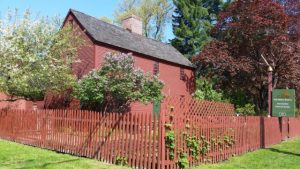
Noah Webster House
Though West Hartford native Noah Webster was a prolific writer, he is best known for the dictionary that bears his name. The famous wordsmith spent his formative years in the small historic farmhouse that still stands at 227 S. Main Street, though the 90 acres that once comprised the property have been whittled down to one. Visitors to his childhood home can learn about how the staunch patriot created the once ubiquitous Blue-Backed Speller in 1783 (still in print today), because he believed that to be an independent country, America needed to teach its children to speak, write, and spell in American – not British – English. An American Dictionary of the English Language, which took the lexicographer 26 years to complete, contained more than 65,000 words and their definitions, and further helped to standardize American spelling. “He gave writers the tools to write their great works,” says Jennifer DiCola Matos, executive director of the Noah Webster House. In addition to celebrating Webster’s accomplishments, the Noah Webster House also celebrates the written word and the spoken word through poetry nights, book talks and author events. Noah Webster House, 227 South Main Street, West Hartford. (noahwebsterhouse.org)
Monte Cristo Cottage
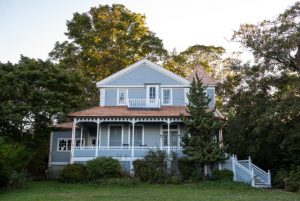 The boyhood summer home of playwright Eugene O’Neill, this New London cottage overlooking the Long Island Sound was named in honor of his father, actor James O’Neill, who played the lead role in both the stage and film adaptations of The Count of Monte Cristo. America’s only Nobel Prize-winning playwright, Eugene O’Neill set two of his most famous works – Long Day’s Journey into Night and Ah, Wilderness! at the cottage. Visitors to this national historic landmark, which is operated by the nearby Eugene O’Neill Theater Center in Waterford, can gain insight into the playwright’s life and work. Monte Cristo Cottage, 325 Pequot Avenue, New London. (theoneill.org/mcc)
The boyhood summer home of playwright Eugene O’Neill, this New London cottage overlooking the Long Island Sound was named in honor of his father, actor James O’Neill, who played the lead role in both the stage and film adaptations of The Count of Monte Cristo. America’s only Nobel Prize-winning playwright, Eugene O’Neill set two of his most famous works – Long Day’s Journey into Night and Ah, Wilderness! at the cottage. Visitors to this national historic landmark, which is operated by the nearby Eugene O’Neill Theater Center in Waterford, can gain insight into the playwright’s life and work. Monte Cristo Cottage, 325 Pequot Avenue, New London. (theoneill.org/mcc)
Gillette Castle
Built from Connecticut stone atop one of a series of hills known as the Seven Sisters, this majestic, modern-day castle overlooking the Connecticut River in East Haddam was once home to William Gillette, the American actor, playwright and director who brought Sherlock Holmes to life on stage and screen. Another product of Nook Farm, Gillette was cast in his first speaking role by his neighbor Mark Twain, in a theatrical adaptation of The Gilded Age, but soared to stardom and made his fortune playing Holmes, first in the play he adapted from Sir Arthur Conan Doyle’s Sherlock Holmes stories, and later in the film, which he also wrote. Mystery lovers will especially admire this 24-room mansion, once referred to as “Gillette’s Folly,” which is filled with secret doors, puzzle locks, and hidden mirrors, and features many other eccentricities, including built-in couches, light switches carved from wood, a table that moves on tracks, and 47 distinctly-styled doors. Like the plays and screenplays Gillette penned, the castle exemplifies quality craftsmanship. Gillette Castle State Park, 67 River Road, East Haddam. (stateparks.com/gillette_castle.html)
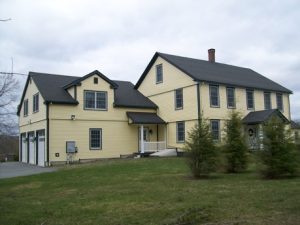
Crosswicks Cottage
Award-winning children’s book author Madeleine L’Engle, who received the Newbery Medal for her science fantasy novel A Wrinkle in Time in 1963, owned this colonial farmhouse on West Street in Goshen from 1952 until her death in 2007. It is here, according to her granddaughter Lena Roy, that L’Engle “disappeared to her ‘ivory tower’ above the garage to write – and it is this setting that inspired many of the fictional places in L’Engle’s books. Like Crosswicks Cottage, the Murrys’ house in A Wrinkle in Time is 200 years old. Both homes have a “star-watching rock” in the backyard, as does the Austins’ farmhouse in L’Engle’s Austin Family Chronicles (a series that includes the 1960 book Meet the Austins).
“Hawk Mountain” near the Austins’ house is a fictionalized version of Mohawk Mountain in Cornwall.
The windows in L’Engle’s bedroom at Crosswicks Cottage looks out onto the Litchfield Hills, the real-life version of the “worn-down mountains” that can be seen beyond the Murrys’ property in The Time Quintet (of which A Wrinkle in Time is a part). Crosswicks Cottage, 93 West Street, Goshen. (cwhf.org/educational-resources/historic-sites/madeleine-lengles-residence-crosswicks-cottage)
Real-life Inspirations for Famous Fictional Settings
Madeline L’Engle is not the only author to find inspiration in Connecticut places. The fictional town of “Cranbury” in award-winning children’s author Eleanor Estes’ classic book The Moffats is based on her life in West Haven. Other literary destinations throughout the state suggest that many writers draw on their physical surroundings – or have actual locales in mind – when they create the fictional worlds that capture their readers:
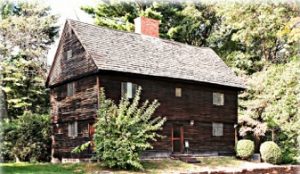
The Witch of Blackbird Pond
The historic Buttolph-Williams House on Broad Street in Wethersfield, with its romantic interiors and colonial – and somewhat medieval-looking – architecture, inspired the setting for local author Elizabeth George Speare’s classic young adult novel, The Witch of Blackbird Pond. Not only does Kit, the book’s protagonist, live in the fictionalized version of this Connecticut landmark, but other places in the novel can also be traced to real-life settings in Wethersfield. Wethersfield Cove is the real Blackbird Pond; Great Meadows, the only place Kit really feels at home in Wethersfield, is a stretch of land along the west side of the Connecticut River; and the Congregational Church in which Kit stood accused of witchcraft is based on the First Church of Christ on Main Street. Buttolph-Williams House, 249 Broad Street, Wethersfield. (webb-deane-stevens.org/historic-houses-barns/buttolph-williams-house/)
Arsenic and Old Lace
The unremarkable brick house at 37 Prospect Street, a quiet suburban street in Windsor, was once referred to by the Hartford Courant as a “murder factory.” Here, Amy Archer-Gilligan, who ran a home for the aged in the early 1900s, systematically poisoned more than two dozen residents over a period of 10 years to make room for other paying customers – and inspired playwright Joseph Kesselring to write the play Arsenic and Old Lace, a comic retelling of Gilligan’s crime story.
The Amy Archer-Gilligan House, 37 Prospect Street, Windsor. (tourwindsorct.org/historic/AmyArcherGilliganH)
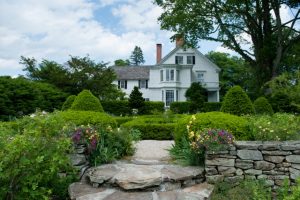
The Lilac Girls
Fans of Martha Hall Kelly’s Lilac Girls will be delighted to discover that the real life country home and gardens of one of the book’s protagonists, New York socialite and philanthropist Caroline Ferriday, can be found in Bethlehem and is open to the public. This historic, federal-style home – and its beautiful gardens, replete with lilacs – makes an appearance toward the end of the novel. Ferriday has helped to bring Kasia, one of the so-called “rabbits” (who, like lab animals, were experimented on by the Nazis at Ravensbrück Concentration Camp) to America. The photo of the rabbits – a group of 74 Polish women for whom Ferriday raised money to help after World War II – sits on a desk in her bedroom at the Bellamy-Ferriday House, and inspired Kelly to write the historic novel. It is in these gardens that Ferriday tells Kasia that her father always liked the fact that lilacs only bloom after a harsh winter, conveying to Kasia that the horrors she and her sister have experienced are now behind them. The Bellamy-Ferriday House and Garden, 9 Main Street North, Bethlehem. (ci.bethlehem.ct.us/bellamy_ferriday.htm)
Fertile ground for writers
Determined literary-minded sleuths can certainly find other traces of the countless writers who have called Connecticut home. When Arthur Miller moved to Roxbury with his then-wife Marilyn Monroe in the mid 1950s, for example, he built a small writing studio and seeded a pine forest behind his home. Today, that forest consists of about 6,000 trees, covering about 350 acres in Roxbury and Woodbury. The free-standing studio has recently been moved to storage, waiting to be transferred to a permanent home elsewhere in Roxbury, so visitors will someday be able to see where the Pulitzer Prize-winning playwright created many of his works.(arthurmillerstudio.org)
Meanwhile, the James Melville House in Stonington, designated a national historical landmark in 2016, offers a glimpse into the life of author and poet James Melville, a significant force in 20th century American literature.
Connecticut remains fertile ground for literary talent. Among the many writers residing here today are Stephanie Meyers of Twilight fame, Eat Pray Love’s Elizabeth Gilbert, and the prolific Wally Lamb, whose latest novel is I’ll Take You There. Local authors can be seen (and heard) at readings and book talks in the few remaining independent bookstores scattered around our state, as well as at libraries and venues like the Storyteller’s Cottage in Simsbury, adding to the abundant selection of our region’s literary destinations.


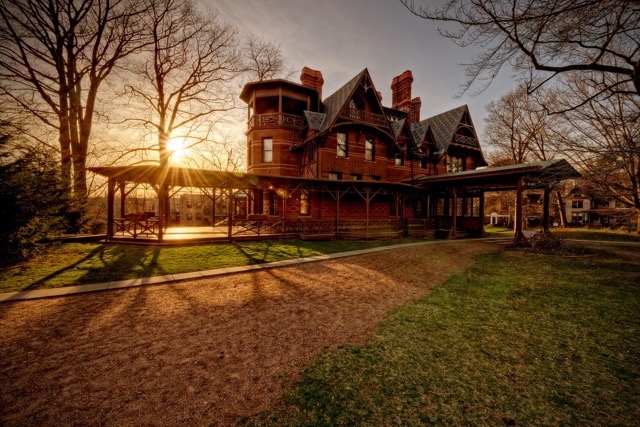



More Stories
Wadsworth Atheneum Museum of Art: (Un)Settled Art Exhibition Moves Beyond Classic Landscapes
On Stage and Off, With Photographer James Meehan
FALL ARTS PREVIEW